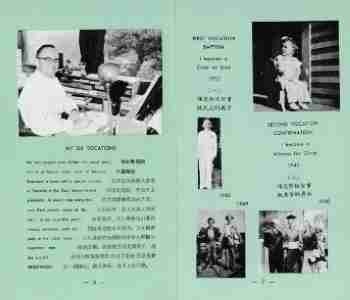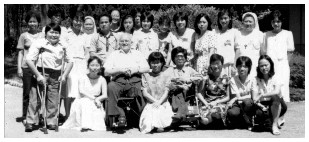

My first 75 years: a map
by Robert Ronald

Usually the course of a person’s life follows a common pattern. First there is a period of formation and preparation. Then there are years of productive activity, during which they marry and raise children. Finally, comes retirement and gradual decline until death.
It is during those first years, that one discovers and develops his or her abilities, interests and aspirations. If lucky and the opportunities present themselves, we eventually succeed in becoming the persons we wish to be. Unfortunately, it often happens that because of economic or political or environmental reasons, those potential abilities and hoped for ambitions are given no chance to develop and people are condemned to lives of drudgery and unfulfilled hopes.
This fortunately does not mean that their lives were wasted, because the value of a human life is not measured by what might have been, but by the way it deals with what is. The slums of the world’s cities and the rural lands where peasants barely manage to survive are full of people who under different circumstances would be doctors and lawyers, musician and artists, entrepreneurs, leaders and industrialists, instead of just men and women struggling the best they can, whose greatness and achievements are known only by God.
This initial period of preparation generally lasts up to the end of a person’s education, training or apprenticeship, ten or twenty years or more, after which they enter the career of their life’s work. For those deprived of education, the training or apprenticeship may begin while they are still young children or they may be thrust directly into forced labor in factories or fields. Some people never find a niche for themselves, but just drift from job to job all their lives. Some take a while of searching before settling down. Still others, like myself, end up wearing several hats. And it took me a full 39 years of preparation before I finally began my life’s work.
When I entered the Jesuits right after graduation from high school, the normal period of Jesuit preparation lasted 15 years: two years of novitiate, five years of college, three years of teaching in a Jesuit school, four years of theology and a final year of pastoral training. In my case, getting polio along the way added two more years. Then at the ripe age of 36 I entered the University of Arizona in Tucson to study and train to become a vocational rehabilitation councilor, so it wasn’t until two months after my 39th birthday that I finally began my life career.
From Dec. 1, 1971 to Dec. 31, 2002 I was employed by the Department of Physical Medicine and Rehabilitation of the Veterans General Hospital Taipei as a Technical Consultant for Vocational Rehabilitation and Occupational Evaluation. Wearing this hat, I supervised and administered assessment tests and job samples to persons with physical disabilities to help them identify the most suitable areas for vocational training and employment. I also personally designed and developed two Pictorial Occupational Preference Inventories, one using drawing of people at work (drawn by professionals) for the general population and one using photographs (taken by others) of jobs suitable for persons who are mentally and learning impaired. At the same time I composed several computerized attention tests to evaluate and train students with suspected attention deficits. From time to time I also taught classes or delivered lectures about vocational rehabilitation.
In my second or third year at the Veterans Hospital I created and put on a second hat when together with Mr. Ignatius Huang Chai-Tsai I initiated Operation De-Handicap. Its main purpose was to provide counseling and referral services to persons with physical disabilities who had finished their courses of medical rehabilitation and had returned home untrained, jobless with uncertain futures. Ignatius founded a quarterly magazine for the disabled and became a much respected consultant in the community about all aspects of rehabilitation and the removal of architectural and other barriers. He continues to edit the magazine and manage a webpage about rehabilitation, but otherwise Operation De-Handicap is slowly running down into retirement. There are now plenty of other agencies and associations to pursue its goals. Though the honorary hat of Director still rests upon my head, I suppose, I was always on the sidelines and all the credit for everything that O.D.H. ever accomplished rests squarely on the shoulders of Ignatius and Mr. David Chi Li-wei who joined the team for many years.
During all that time I was still wearing my original hat, that of a Christian Roman Catholic Jesuit priest belonging to the Society of Jesus. Though my main assignment was to pursue my rehabilitation career, I lived at the nearby Shihpai Catholic Church where I was responsible for saying the weekday morning Mass and helped out at the masses on Sundays.
When a person’s career is terminated by a mandatory retirement age, as mine was when I reached 70 years old, one finds himself or herself standing on the threshold of a new life. For some it is a moment of liberation from responsibilities that were becoming harder and harder to bear; for some it is the beginning of the long awaited retirement they have carefully and lovingly planned for; for still others, it is an opportunity for beginning a new career. For some, finding themselves idle and aimless and unprepared, it is beginning of an unhappy decline into emptiness.
For me, retirement meant that I was at last free to move into the Jesuit community that I had always been a member of, but in absentia. And I was given the opportunity to begin a whole new career, that of writer. Going through some old papers, I discovered six fables I wrote over 40 years ago and had forgotten. That started me composing some new ones and I have so far written 146 of them, a most enjoyable creative pass time. I have also been invited by the Ricci Institute to join the staff of Renlai Magazine as English consultant and am writing a series of editorial essays that already numbers more than 70.
So this is where I am now in this odyssey of my life.
